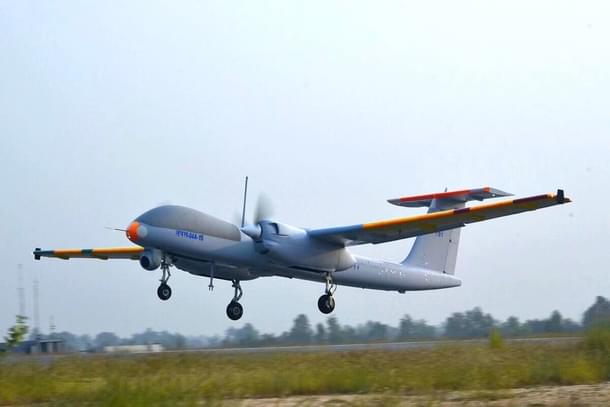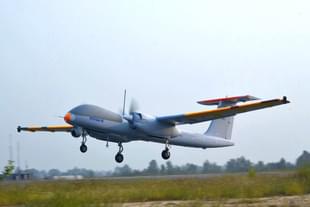Defence
Are The Armed Forces Finally Embracing The Concept Of Iterative Development?
Ujjwal Shrotryia
Jun 27, 2024, 11:24 AM | Updated 12:53 PM IST
Save & read from anywhere!
Bookmark stories for easy access on any device or the Swarajya app.


The Indian Armed Forces may finally be adding the concept of iterative development to their dictionaries.
The reports of the Indian Air Force (IAF) and the Indian Navy being interested in acquiring 10 Tapas medium-altitude long-endurance (MALE) unmanned aerial vehicles (UAV) hint towards this change.
The IAF is supposed to be the lead service in acquiring these Made-in-India drones. Six of the 10 are meant for the IAF, and the remaining four for the navy.
This comes as a surprise to many since the Tapas programme was removed from the Defence Research and Development Organisation's (DRDO’s) mission mode projects.
Mission mode projects are taken by DRDO that have to be completed in a time-bound manner to achieve specific goals or targets, allowing delivery of actual products to the user on time.
Tapas was unable to meet the joint qualitative requirement (QR) of an endurance of 24 hours at 30,000 feet and was only able to demonstrate 18 hours of endurance at 28,000 feet in the required timeframe, leading to the closure of the project.
Instead, four Dhristi-10 MALE UAVs were bought.
Dhristi-10 is nothing but an Israeli Hermes 900 UAV assembled by Adani with a different name. (You can read more about it here.)
Questions were asked why limited quantities of Tapas were not bought, which would have given iterative development a chance.
Iterative development in military hardware means rolling out an initial version of the gear to the military, even if it doesn't tick all the boxes right away. The troops start using it, and as more orders come in, the supply chains get smoother and suppliers get more funds. This leads to tweaks and upgrades, so over time, the equipment gets better and eventually meets all the needed specs.The United States' F-35 jets are a prime example of this.
Even though the initial variants of the F-35 did not meet all requirements, the US persisted with the project, exported it to several nations, and made it a class-leading product.
By showing their willingness to buy 10 Tapas UAVs, it looks like the armed forces are finally beginning to embrace this idea.
If this order goes through, the biggest benefit will be for Tapas' supply chain. It always takes time for the first batches of any product — whether it's a drone, a main battle tank, or a car — to roll off the production line with the required quality.
Most of the niggles or production quality issues get sorted in further batches. Therefore, this order will give time for the production line to settle.
The second benefit will be the funds that will flow to the suppliers of sub-components that go into Tapas. They can use these funds for further development and refinement of parts and components, making Tapas a better product.
Third, it will grant time to DRDO to develop a new 180 HP engine to replace the currently imported engine of the same power rating. The new indigenous engine will be lighter and more fuel-efficient.
With some rounds of iterative development, the overall product will be a much better Tapas that fulfills all the initial QRs of the forces.
The armed forces are not alien to the concept of iterative development as well.
The Indian Navy has been a proponent of this for quite a while. The Vishakhapatnam class destroyer is the first instance that comes to mind. The Vishakhapatnam class is a development over the Kolkata class destroyer, which itself was developed learning from the lessons of Delhi class destroyers.
As is the progression from Shivalik class to Nilgiri class stealth frigates. The navy is the only service that has shown some interest in this concept for quite a while.
Another example of iterative development is the Tejas fighter jet.
Despite the IAF giving a cold shoulder to Tejas in its initial stages, Tejas Mk-1A is ultimately an iterative development of Tejas Mk-1. The positions of its line-replaceable units (LRUs) were changed for better maintainability, its weight was reduced, and better software, computers, a more capable electronic warfare system, and a powerful AESA radar were installed.
The IAF has now started to warm up to this concept.
This apparent change could also be due to a push coming from the top levels of the government in an attempt to get armed forces rid of their fascination with imports.
The Indian Army, however, just as in the past, is showing a reluctance to this.
For example, on just Monday night (24 June), it was reported that the army is looking for joint production of Javelin anti-tank guided missiles (ATGMs) despite DRDO having developed a man-portable anti-tank guided missile (MPATGM). The missile has gone through several rounds of successful trials, but even after six years (its development started in 2018), it is still undergoing trials.
Just in April this year, it completed its technology development trials and is now set to undergo another round of trials — final user evaluation trials.
Instead of forcing MPATGM to go through many stages of trials, a more nimble policy of clubbing user trials with development trials could have been a better path to shorten the induction timelines, but was not explored.
Even if some issues may have cropped up in the initial batches using the above approach, they could have been rectified in further batches.
These reports of joint production of Javelin ATGM could be interpreted by many as a lack of interest in MPATGM and a general dislike for Made-in-India products by the army.
Similarly, discussions on the joint production of the Stryker armoured personnel carrier (APC) with the United States is another reason to doubt the army’s intent. (You can read over coverage over it here.)
Just like MPATGMs, India has an indigenous alternative in the form of the Kestrel APC made by Tata with DRDO. Again, any issues or niggles in the initial batches could have been rectified in the subsequent batches, but was not so.
These discussions, therefore, with the US strengthen these doubts even further.
Whether this resurgence in giving Indian products a priority by the IAF and navy is self-embraced or pushed by the government, it is critical for the forces to show trust in the Indian-made products or risk getting embroiled in another cycle of dependency on foreign suppliers.
Staff Writer at Swarajya. Writes on Indian Military and Defence.





